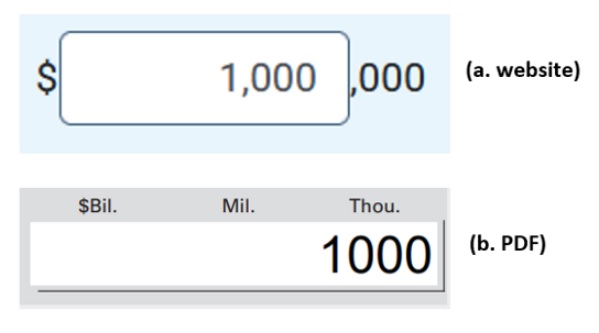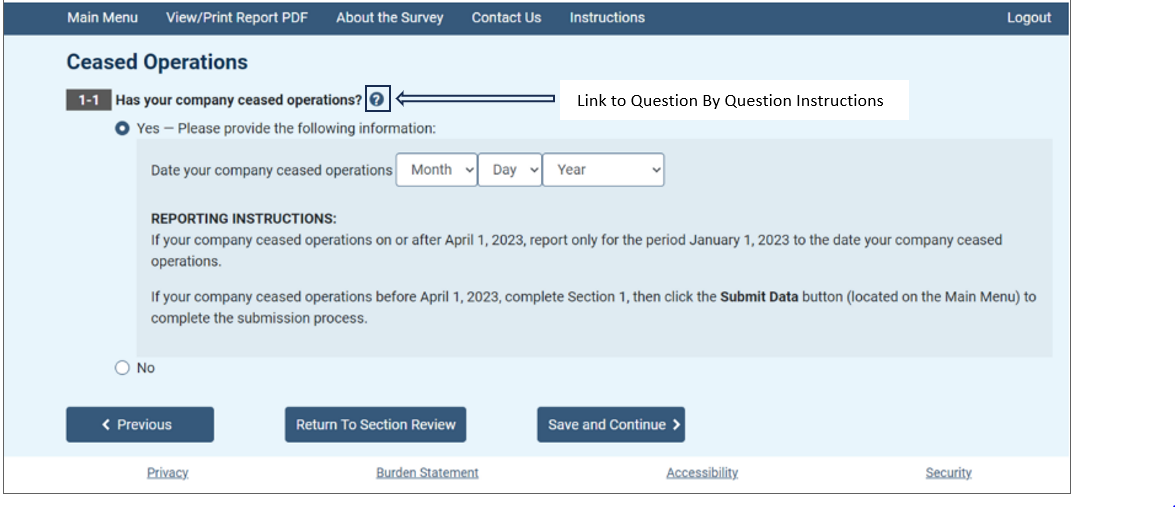Business Enterprise Research and Development (BERD) Survey FAQ
Business Enterprise Research and Development Survey (BERD) FAQ
Yes, YOUR RESPONSE IS REQUIRED BY LAW. Title 13, United States Code, Sections 8(b), 131, and 182, and Title 42, United States Code, Sections 1861-76 (National Science Foundation Act of 1950, as amended), and Section 505 within the America COMPETES Reauthorization Act of 2010 authorize this collection. Sections 224 and 225 of Title 13 require your response. The U.S. Census Bureau is required by Section 9 of the same law to keep your information CONFIDENTIAL and can use your responses only to produce statistics. The Census Bureau is not permitted to publicly release your responses in a way that could identify your business, organization, or institution. Per the Federal Cybersecurity Enhancement Act of 2015, your data are protected from cybersecurity risks through screening of the systems that transmit your data.
The U.S. Census Bureau is required by Title 13 United States Code, Section 9, to keep your information confidential and can use your responses only to produce statistics. The Census Bureau is not permitted to publicly release your responses in a way that could identify your business, organization, or institution. Per the Federal Cybersecurity Enhancement Act of 2015, your data are protected from cybersecurity risks through screening of the systems that transmit your data.
Decision makers in both the public and private sectors make better decisions about R&D policies when they have better information about business R&D. This form was developed with the input of many company leaders with the goal of making the data useful to the executives of the companies providing the data as well as policy-makers in government.
Approximately 47,500 out of the estimated 1.1 million non-farm, for-profit businesses with 10 or more paid employees operating in the United States will receive this survey. Companies in industries known to have significant R&D activity are included in the survey automatically, and the remaining companies are statistically sampled to allow for the production of estimates for different industries and geographic locations.
Provide your best estimate if exact values are not available. Because every company tracks and manages their R&D differently, we expect companies may have to provide estimates for some questions on the form. Due to the unique nature of R&D, your best estimates will still provide useful information to the people who use these data.
The survey asks for values in thousands of U.S. dollars. Within the online reporting instrument, this is addressed with a placeholder that uses a comma and three zeros (,000) after the input field. However, when viewing the PDF report, only what was in the input field will be shown because the reporting units are already taken into account on the form. For example, someone trying to communicate that they have total revenues of $1,000,000 (One Million U.S. dollars) will see the following:
In diagram (a) the amount appears with the placeholder following the input field for sales. This is how it will be seen on the webpage where the information is being entered. For diagram (b) the value appears without the placeholder. Instead, there are lettering representations of the units above the value field, starting with the thousands. This is the way that it will be displayed within the PDF. In both cases the final report will reflect $1,000,000 (One Million U.S. dollars).

The BERD Survey collects the following information from companies:
- Financial information about R&D the companies pay for (R&D expenses)
- Expenditures for property, plant, and equipment including capitalized software
- Strategic and technical information about the companies' R&D expenses
- Financial and technical information about R&D that is paid for by others such as contract R&D or R&D funded by a government grant
- Information about the companies' R&D employees, focusing on those who work on R&D activities
- Section 7, Intellectual Property and Technology Transfer
Questions removed in 2024:
- 3-10, 3-11 and 3-12 removed
- 2-20, 2-21 and 2-22 removed
- 4-2, 4-3, 4-4 & 4-9 removed
- 5-5 through 5-9 removed
- 5-19 through 5-23 removed
Questions that changed positions and other changes:
- 2-23 & 2-24 are now 2-20 & 2-21
- 2-25 is now 2-22
- 3-13 through 3-23 were renumbered to 3-10 through 3-20
- 4-5 through 4-8 renumbered to 4-2 through 4-5
- 4-10 is now 4-6
- 5-10 through 5-33 renumbered to 5-5 through 5-23
- Section 7, Tax Topics is now Section 8, Tax Topics
Because R&D data are so important to competitiveness in today's economy, many companies and organizations are very interested in analyzing data from this survey. Some of these data users include:
- Bureau of Economic Analysis (BEA). The BEA will include R&D in its system of national accounts which measure the economic well-being of the country. The data from this survey are a key input into these accounts, which feed into the estimates of the U.S. Gross Domestic Product (GDP).
- The White House. In 2006 The White House issued the American Competitiveness Initiative to "increase investments in research and development, strengthen education, and encourage entrepreneurship." Data on R&D are delivered to The White House and the Office of Science and Technology Policy (OSTP) for policy uses.
- National Science Foundation (NSF). NSF produces a series of publications containing business R&D data. These include multiple Info Brief publications, and data tables containing the results of the most recent Business R&D survey, the biennial National Science Board report Science and Engineering Indicators, the National Patterns of R&D Resources series, and the S&E State Profile series.
- Congress. Members of Congress use R&D data to inform their decisions on policies intended to influence investment in innovation such as the R&D tax credit.
- Trade and professional organizations. A wide range of organizations use R&D data to analyze trends in their industries, benchmark the performance of their members, develop forecasts, and evaluate public policy.
- Media. The media use these data for news reports and background information on the state of science and technology in the economy.
- Business executives. Private businesses use these data to measure market share, analyze business potential, benchmark performance against industry averages, and plan investments.
Yes, on the Information for Respondents page there are Question by Question Instructions to help you complete the survey. There are also links to the Question by Question Instructions placed on each question within the online reporting instrument.

Yes. Both are required by law (Title 13, United States Code, Section 224). Although AIES is a re-engineered survey designed to integrate and replace several existing surveys, it does not collect the detailed Research and Development data collected on BERD. BERD is conducted jointly by the U.S. Census Bureau and the National Science Foundation’s Center for Science and Engineering Statistics (NCSES).
R&D is planned, creative work aimed at discovering new knowledge or developing new or significantly improved goods and services. This includes: a) activities aimed at acquiring new knowledge or understanding without specific immediate commercial applications or uses (basic research); b) activities aimed at solving a specific problem or meeting a specific commercial objective (applied research); and c) systematic use of research and practical experience to produce new or significantly improved goods, services, or processes (development). The term "research and development" does NOT include expenditures for:
- Costs for routine product testing, quality control, and technical services unless they are an integral part of an R&D project
- Market research
- Efficiency surveys or management studies
- Literary, artistic, or historical projects, such as films, music, or books and other publications
- Prospecting or exploration for natural resources
R&D may be confused with other activities that are scientific or technological in nature. One way to distinguish R&D from other activities is that R&D involves novelty and the attempt to resolve scientific or technological uncertainty. If the solution to a problem is obvious to someone familiar with the area concerned, then it is not R&D.
This means that many software and website development projects are not R&D. In order for a software development project to be considered R&D, its completion must be dependent on a scientific and/or technological advance and the aim of the project must be to overcome some scientific/technological hurdle. Developing a new website targeted at a specific market would not be considered R&D if it simply applies existing technology and techniques. However, the application of social networking research to develop a novel algorithm could be considered R&D assuming it involves the resolution of some scientific and/or technological hurdles.
In other areas, such as the social sciences, many activities that are commonly called "research" fall outside this survey's definition of R&D because they employ known techniques in a routine manner to gather information. The goal of these activities is not to advance scientific/technological knowledge. For example, conducting a telephone poll of voters to assess opinions about health care legislation is not R&D.
If you are a survey respondent and you are uncertain as to whether your company's activities should be reported as R&D, please contact us.
No. Some activities that satisfy the IRS criteria for “qualified research” fall outside the scope of this survey’s definition of R&D. IRS regulations issued in January 2004 (TD 9104) abandoned the requirement that qualified research must have the objective of obtaining knowledge that exceeds, expands or refines the common knowledge of skilled professionals in a particular field of science or engineering. Since that time, activities that are “new to the taxpayer” but not necessarily “new to the world” could qualify for the tax credit if other criteria were met. However, for the purpose of this survey the novelty of an R&D project is still important as the survey’s goal is to measure investment in activities intended to “increase the stock of knowledge and devise new applications of available knowledge.”
In general, activities that involve uncertainty and a process of experimentation but do not aim to advance the state of the art in the industry or devise a new or significantly improved product or process should be excluded from R&D questions on this survey. Example 1: An engineering firm applying best practices to resolve technical uncertainties during the design phase of a customer sponsored project may have activities that qualify as research for purposes of the IRS tax credit, but these activities should not be reported as R&D on this survey. Example 2: An engineering firm works to devise a new method for designing earthquake resistant buildings that has never been used before. This activity should be reported as R&D on this survey and would also likely qualify as research for purposes of the IRS tax credit.
Share
 Yes
Yes
 No
NoComments or suggestions?


Top